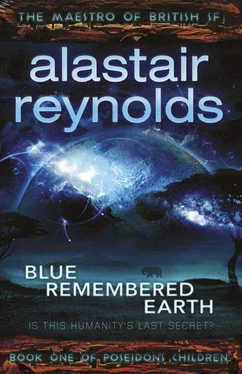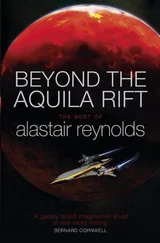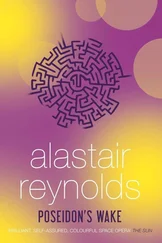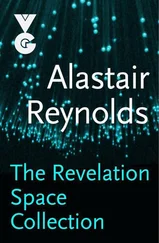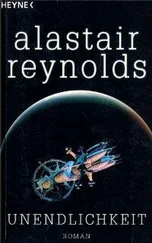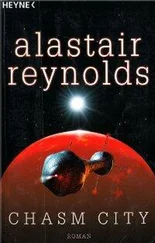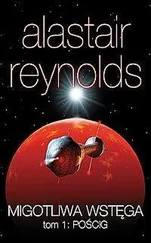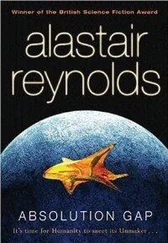Geoffrey caressed the black fragment, convinced that he’d already handled it. ‘This is a piece of Phobos?’
‘Something that ended up there. People have known about the Monolith for at least a hundred and fifty years – they saw the shadow it cast long before they got a good close-up look at the thing itself. For a while, there were cranks who thought it might be an alien artefact – a ship, a sentinel, something like that. But when we got there we found that it was exactly what all reasonable people had always expected: a very big boulder, jammed into Phobos like a splinter. Impressive, hard to miss – a viable tourist attraction. But not an alien machine.’
‘Then why am I holding this?’
‘I wasn’t the first to see it up close. Not even the fiftieth. By the time I got there, nearly a hundred people had already come through Phobos on their way to Mars – I was the ninety-eighth. And countless robot eyes had already scanned and photographed the Monolith. They’d seen it for what it was: a clearly natural feature, the result of some ancient collisional process.’ Eunice waited a breath, then added, ‘But they’d all missed something.’
‘Something you didn’t,’ Jumai said.
‘I found debris,’ Eunice said, ‘near the base of the Monolith, loosely scattered over the Phobos surface material – bound there only weakly, due to the low gravity. That thing had been sticking up from the crust like a target in a shooting gallery for countless millions of years. Eventually something had hit it, some speck of cosmic dirt, and chipped off an entire face. I was looking at the debris, the shards of that high-velocity impact. Others must have realised what had happened, I suppose. But it had never occurred to any of them to pay attention to the debris.’
Geoffrey was still studying the piece in his hand. ‘You realised there was more to it than just debris.’
‘You can’t have missed those fine surface markings. On the face of it, they could be anything: spallation tracks from cosmic rays, crystalline defects… but something about them held my eye. I picked up another piece, lying close by. Then another. Eventually – and my suit air was running low by then – I found a matching pair. I fitted them together and saw that the scratches connected, and that they appeared to form part of some larger… diagram.’
‘I’d laugh if there was any possibility you might be joking,’ Geoffrey said.
‘I went back out there many times over the following weeks. I gathered as many of the fallen shards as I could find, bringing them back to the encampment. It was easy enough to keep the pieces hidden in my personal effects, and since we were going into a gravity well, not crawling out of one, there was no mass restriction for the trip down to Mars.’
‘Did Jonathan know?’ Geoffrey asked.
‘I saw no reason to keep it from him. He was my husband, after all. And I didn’t have any notion of what the scratches would actually turn out to symbolise. Obviously, their mere existence was astonishing. But beyond that… even if I went public, I couldn’t see it being more than a seven-day wonder. So what if the scratches appeared to point to an alien presence on Phobos? It couldn’t be proved, not rigorously. Someone could always claim that the shards had been faked by one of the first hundred. And if aliens had been there, a million or a billion years ago, they’d done nothing beyond leave that one set of scratches. Like someone stopping to take a piss at the roadside before carrying on.’
‘Graffiti. Scratched on the Monolith,’ Jumai said. ‘The kind of thing someone might do if they were stuck somewhere, bored, with nothing else to occupy them.’
‘Jonathan had studied electrical engineering before making his fortune in telecomms,’ Eunice said. ‘As part of his studies, he’d taken modules in modern physics. When I showed him the pieces, arranged as well as I was able, he said that the scratched forms reminded him of something. They look like little men, don’t they, or demons?’
‘That’s what I thought,’ Geoffrey said.
‘To Jonathan they were reminiscent of Feynman diagrams: little conceptual drawings encoding the interaction histories of subatomic particles. They weren’t Feynman diagrams, clearly – that would be as unlikely as finding inscriptions in our own alphabets or number systems. But they were analogous. The lines are the trajectories of particles. The squiggles are the forces mediating the reactions between them. The spirals are by-products of those reactions – other particles, packets of energy. That was just intuition, though. It would take a working physicist to say more than that. A good one, too. And someone I could trust.’
‘And you just happened to know someone,’ Jumai said.
‘We established contact while I was on Mars,’ Eunice answered. ‘He was fascinated by the rock drawings. He said that they already encoded the entire edifice of existing physics, as well as implying the correctness of several models that were still at the preliminary stage. What was more important, though, was that the diagrams pointed to physics we hadn’t begun to probe. Quark-quark interactions that seemed forbidden, on the basis of the known gauge symmetries. Do you know much about quarks? No, obviously not, or you’d have realised that they come in three colours: blue, red and green, like cheap plastic jewels. Or that when Sunday finds me reading a copy of Finnegans Wake , there’s a reason for that.’
‘I don’t think we did too badly to get this far,’ Geoffrey said.
‘The point was, if the diagrams were right…’ Eunice shook her head, as if she was still experiencing the awe of that moment. ‘We could do incredible things. We could build engines powerful enough to fling a ship to Neptune in weeks. But that was just the start of it – the least dramatic breakthrough.’ She smiled again. ‘My physicist was right, too. The engine that brought you to Lionheart was the fruit of that very early research. Really, it’s just a standard VASIMR motor with a few wrinkles smoothed out. The kind of thing we’d probably have stumbled on eventually, given enough time. But this wasn’t a stumble. We saw how to make it better, and it worked. You can’t know how that made us feel. We’d proven that there was testable science in the rock diagrams. But if the least dramatic predictions gave us an engine five times faster than anything else out there, what would we be getting into when we started testing the really frightening predictions?’
‘You tell us,’ Geoffrey said.
‘Even with the scope of the equipment in Lionheart, we could only probe the margins of the new physics. But that was enough, for now. These basic experiments have already pointed to a technology so potent that it would make the engine in that ship look like a toy.’ Eunice gestured at the black mosaic. ‘We can do much better than that. For a hundred and fifty years we’ve been locked into a few hours of space around one little star. Even being able to reach Neptune in a few weeks doesn’t alter that. But now we have the means to break out of the solar system. A stardrive , if you will. If the physics is to be believed, then true interstellar travel is now within our grasp. Let’s be clear what we’re talking about here. It’s still going to take a long time. A few per cent of the speed of light, that’s what we’re looking at. Pitiful and inadequate compared to the scale of things. Horsepiss against all that cosmic immensity. Even the nearest solar system will still be hundreds of years away. But that’s hundreds, not tens of thousands!’
She was becoming increasingly animated, as if this whole speech was approaching a carefully scripted climax.
Читать дальше
